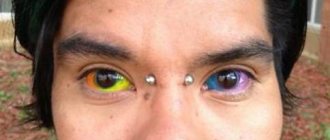132
Author of the article
Tsareva Elena Vladimirovna
Reading time: 11 minutes
A A
The cause of conjunctivitis can be any external influence, including dirty hands, cosmetic samples in stores, or contact with a sick person. But any manifestation of the disease requires immediate contact with a doctor, who can determine the type of conjunctivitis and prescribe appropriate treatment. Albucid is considered one of the most used drugs for the disease.
- Description and composition of the drug
- Medicinal properties and principle of action
- Indications
- Contraindications
- Reaction and side effects
- Preparation
- Features of use in adults
- Use in children
- For different types of illness
- Price and analogues
- Conclusion
Description and composition of the drug
Albucid is an antibacterial eye drop that is aimed at eliminating various types of bacteria. Ophthalmologists often prescribe them to both adults and children for various eye diseases, including conjunctivitis.
Currently, this medicine is available in the form of transparent drops, packaged in sterile plastic bottles of 5 or 10 ml, equipped with a dropper. The main active ingredient of Albucid is sulfacetamide, which is contained in 1 ml of the drug in an amount of 20 mg. Auxiliary components are sodium thiosulfate, hydrochloric acid and purified water.
A few words about the treatment of conjunctivitis in children
As I already said, Albucid antibacterial drops can treat conjunctivitis even in newborns, but you must first discuss this point with an experienced specialist.
The action of sulfacetamide is aimed at preventing the occurrence of infection and disrupting the formation of amino acids in pathogenic bacteria. Installations should be carried out on infants 4 to 6 times a day, dripping 2 drops into each eye.
Important! The decision on the frequency and number of instillations, as well as the duration of therapy, should be made by the ophthalmologist, taking into account the type of disease and severity of symptoms, as well as the age and health of the baby.
Medicinal properties and principle of action
Albucid begins to act immediately after penetration into the mucous membrane and tissue of the eye, as it is absorbed into the systemic bloodstream through the inflamed conjunctiva of the eye.
The drug belongs to the group of sulfonamides, has a wide spectrum of antimicrobial action and is used primarily in the treatment of infectious and inflammatory eye diseases that are provoked by pathogenic microflora that are sensitive to the components of the drug. These include blepharitis, conjunctivitis, keratitis and others.
Expert opinion
Ermolaeva Tatyana Borisovna
Ophthalmologist of the highest category, Candidate of Medical Sciences
The active component of the drug stops the proliferation of pathogens, while providing a bacteriostatic effect.
Albucid is able to suppress the action and further reproduction of organisms such as streptococcus, staphylococcus, gonococcus, E. coli, chlamydia and others. It can act as first aid or a means of prevention for various types of conjunctivitis, which are often diagnosed by ophthalmologists in patients.
Indications
Albucid is used for the following diseases:
- Infectious and inflammatory diseases of the anterior part of the eyes.
- Conjunctivitis.
- Barley.
- Blepharitis.
- Keratitis.
- Purulent lesions of the cornea.
- Damage to the eyelids of various origins.
- Prevention of blenorrhea in newborns.
- Gonorrheal diseases in adults and newborns.
- The medicine can be used as a means of preventing eye infection during the rehabilitation period after eye surgery.
Expert opinion
Ermolaeva Tatyana Borisovna
Ophthalmologist of the highest category, Candidate of Medical Sciences
The drug is effectively used in the treatment of bacterial conjunctivitis, but at the same time it may be ineffective in other forms and even cause an increase in the inflammatory process. For example, for viral conjunctivitis, the drug is used after a secondary eye infection is detected.
Contraindications
The main contraindication to the use of Albucid is the patient's hypersensitivity to sulfacetamide and other drugs containing sulfonamide. The drug is also not recommended for use in patients allergic to thiazide diuretics. These drops are used with caution during pregnancy and lactation and only after consultation with a doctor.
Wearing contact lenses also cannot be combined with taking Albucid, so you should avoid contact lenses during the treatment period.
Reaction and side effects
Immediately after instilling the drug into the eyes, slight tingling, burning and even itching may appear, but this does not require discontinuation of the drug. Often, after using the ophthalmic drug Albucid, the patient may experience some side effects and persist during the entire course of treatment:
- Temperature increase.
- Swelling of the conjunctiva.
- Tearing.
- Itching and burning in the eyes.
- Skin rash.
Expert opinion
Ermolaeva Tatyana Borisovna
Ophthalmologist of the highest category, Candidate of Medical Sciences
If symptoms persist for a long time, you should immediately stop using the drug and consult an ophthalmologist.
How can Albucid be replaced in the treatment of conjunctivitis?
If it becomes necessary to replace albucid with any other drops, you should choose ophthalmic solutions that have a wide spectrum of antibacterial action. Such medications include:
- Oftadek.
- Tobrex.
- Tsipromed.
- Levomycetin.
- Phloxal.
Oftadek
Eye drops based on decamethoxin, a substance that has pronounced antiseptic and antimicrobial properties. Drops are prescribed for chlamydial lesions of the organs of vision, conjunctivitis, blepharoconjunctivitis, purulent-inflammatory processes caused by the following types of pathogens:
- Pneumococci.
- Staphylococci.
- Gonococci.
- Streptococci.
- Enterobacteriaceae.
- Meningococci.
The medication is also effective against eye infections with Candida fungi and some viruses.
Side effects can manifest themselves in the form of pain, itching, swelling of the eyelids, increased tear production, and redness of the conjunctiva. Contraindication: hypersensitivity.
Tobrex
The medicine contains tobramycin, a substance that has antibacterial properties and is effective for eye diseases caused by:
- Staphylococcus.
- Streptococci.
- Klebsiella.
- Enterobacteria and other pathogens.
The medication is prescribed for conjunctivitis, blepharitis, keratitis, iridocyclitis, keratoconjunctivitis of bacterial origin.
After administering the medicine to the eyes, itching, swelling of the eyelids and conjunctiva may occur. The product should not be used if you are highly sensitive to tobramycin.
Tsipromed
Drops for the treatment of ophthalmic diseases - uveitis, keratitis, conjunctivitis, dacryocystitis. The pharmacological solution is developed on the basis of tsipromed, a substance that belongs to the fluoroquinolone group of antibiotics and has antibacterial as well as bactericidal properties. Tsipromed is effective for diseases caused by:
- Klebsiella.
- Staphylococcus.
- Streptococci.
- Chlamydia and other pathogens.
After instillation, the medication may cause a feeling of sand, pain and itching in the eyes, hyperemia of the mucous membranes, and photophobia. The medicine cannot be used for the treatment of children under 1 year of age, with hypersensitivity, pregnancy and hepatitis B.
Levomycetin
The medication in the form of eye drops contains chloramphenicol, which has antimicrobial properties and has a bacteriostatic effect. It is active against the following pathogens:
- Streptococci.
- Salmonella.
- Staphylococci.
- Klebsiella.
- Shigella and others.
Drops are prescribed to patients suffering from infectious and inflammatory diseases of the organs of vision. Caused by the pathogens listed above. Thus, this remedy is effective for conjunctivitis, keratitis, blepharitis, keratoconjunctivitis.
After instillation, the medicinal solution can cause swelling, redness and itching in the eyes, and skin rash in the eyelid area.
Levomycetin has such contraindications as pregnancy and breastfeeding, hypersensitivity, liver and kidney failure, fungal infections of the epidermis, eczema.
Please remember that you should consult your doctor before using any eye drops. Improper treatment of conjunctivitis can lead to the development of complications and deterioration of the visual organs.
Preparation
In order to achieve a positive result from treatment with Albucid, you need to follow the instructions for its use :
Did Albucid help you with conjunctivitis?
Not really
- First of all, clean the mucous membrane of the eyes from purulent discharge, if any, using Furacilin solution or chamomile decoction.
- The drug should be slightly warmed by holding the bottle in your hands for several minutes.
- The head should be tilted back, the pupils should be raised up, and the lower eyelid should be pulled down.
- Holding the eyelid with one hand, carefully drop the indicated number of drops of solution into the conjunctival sac; the same procedure is performed with the second eye.
- Next, you need to close your eyes, preventing the drops from flowing out of your eyes. To do this, press the inner corners of your eyes with your fingertips.
- Sit with your eyes closed and your head tilted back for several minutes.
- If liquid still leaks from the eyes, carefully remove it with a napkin or cotton pad.
Expert opinion
Ermolaeva Tatyana Borisovna
Ophthalmologist of the highest category, Candidate of Medical Sciences
The dosage of the drug is prescribed by the doctor individually, depending on the severity of the disease.
Features of use in adults
For the treatment of conjunctivitis in adults, a solution of the drug Albucid 30% is prescribed. In this case, the dosage of drops depends on the severity of the disease and the degree of inflammation. For example, in acute cases of the disease, it is recommended to instill 2-3 drops into each eye up to 6 times a day. As symptoms decrease and the patient's condition improves, the dosage is gradually reduced. After the symptoms of the disease completely disappear, the instillation of the drug is stopped.
Features of the use of Albucid for conjunctivitis
Due to the minimal number of contraindications and side effects, Albucid can be used from the first year of life. To treat eye diseases in children, during pregnancy and breastfeeding, a 20% medicinal solution is used, and in adults, conjunctivitis is treated with a 30% solution of sulfacetamide. Let's take a closer look at how to drip Albucid drops:
- First you need to clear your eyes of any discharge. For this purpose, Dr. Komarovsky recommends using Furacelin solution or chamomile decoction.
- In the initial stages of bacterial conjunctivitis, the affected organs of vision should be instilled up to 6 times a day, with 2-3 drops dripped into each eye.
- As the intensity of the inflammatory process decreases, the dosage of the drug can be reduced. This decision is made by the attending eye doctor based on the individual characteristics of the patient, clinical data and the severity of the disease. In addition, it is necessary to take into account the duration of activity of Albucid - on average, the drug acts for 2-3 hours.
- Before using the drops, the bottle needs to be warmed up a little (to do this, just hold it in your palms for a couple of minutes).
- During installation, the lower eyelid should be pulled down, while preferably looking up.
- It is best to instill in the area located closer to the bridge of the nose.
- Regardless of whether one or both organs of vision are affected, both the right and left eyes need to be instilled.
- After instillation, you should close your eye and lightly press your finger on the inner corner. This is necessary to ensure that the medicine does not penetrate the maxillary sinuses.
- To remove Albucid residues, use gauze, a cotton pad or a sterile napkin.
Speaking about how long to drip a sulfacetamide solution for inflammation of the mucous membrane of the eye, I will say that the average duration of the therapeutic course is 7-10 days, but if necessary, it can be extended. This point should also be discussed with the treating ophthalmologist.
Related article: How to use Oftalmoferon for conjunctivitis?
Use in children
When treating conjunctivitis in children, ophthalmologists recommend the use of Albucid 20% eye drops. In children, conjunctivitis often occurs due to poor personal hygiene. Only an ophthalmologist can prescribe the correct dose of the drug after examining the child and his eyes. Albucid is prescribed according to the age of the child and the course of the disease. In the acute stage of the disease, it is recommended to instill 2 drops into each eye 2 to 6 times a day.
Some parents use the drug as a treatment for the common cold, but this method is not justified, and Albucid is not so effective in this case. The drug is mainly indicated for the treatment of childhood eye infections.
Expert opinion
Ermolaeva Tatyana Borisovna
Ophthalmologist of the highest category, Candidate of Medical Sciences
Before using Albucid in newborns, you should consult your pediatrician. Self-medication with this drug is contraindicated.
Conjunctivitis in a child: how to treat it
This type of conjunctivitis is transmitted by airborne droplets, affecting the nasopharynx along with the mucous membrane of the eyes. Outbreaks of adenovirus infection in children's groups take on the character of an epidemic.
The combination of adenoviral conjunctivitis with catarrhal symptoms in the nasopharynx is characterized by hyperthermia up to 39°C and enlargement of the pre-auricular lymph nodes.
The conjunctiva and eyelids turn red and swell. A small amount of mucus is released from the eyes.
There is lacrimation and photophobia.
If the disease takes a follicular form, films or follicles form on the mucous membrane.
Lesions of the cornea are extremely rare.
Diagnosis of complex damage to the conjunctiva and upper respiratory tract, which is of a viral nature, is carried out on the basis of cytological, virological and serological laboratory tests.
Treatment of viral conjunctivitis is carried out with drops of Albucid (sodium sulfacyl), as a universal medicine for any form of conjunctivitis.
Ophthalmoferon - contain human interferon, which determines its antiviral and anti-inflammatory properties as an immunomodulator. Therapeutic dose is 1-2 drops 6-8 times a day in the acute period, then 2-3 times a day until complete recovery.
Poludan - used to treat eye infections caused by the herpes virus and adenovirus. The drops are created as a result of biosynthesis based on cytokines and endogenous interferons. Therapeutic dose is 1-2 drops 6-8 times a day in the acute period of the disease, then 3-4 times for 7-10 days.
Actipol - created on the basis of endogenous interferon, which gives them antiviral and regenerative properties to restore the mucous membrane. It has the qualities of a strong antioxidant. Therapeutic dose – 2 drops up to 8 times a day for 10 days.
As prescribed by a doctor, treatment of viral conjunctivitis is carried out with antiviral ointments. They are used both in pediatrics and for the treatment of adult patients.
Before giving ointment to children, a little preparatory work is required. The eyes are washed with antiseptic infusions of tea, sage, chamomile (if these herbs are not allergens for the patient), Albucid or drops with interferon are instilled.
After 30 minutes you can apply the ointment. All medications should be used only after consulting a pediatrician or pediatric ophthalmologist.
Florenal is used to treat eye infections caused by chickenpox viruses, herpes simplex and herpes zoster, and adenovirus. Therapeutic dosage - into the conjunctival sac 2-3 times a day for 10-45 days.
Tebrophen ointment - used to treat all types of viral conjunctivitis, used 3-4 times a day.
Bonafton is used to treat conjunctivitis caused by adenovirus and herpes simplex virus. Therapeutic dosage for adults is 0.1 g 3-4 times a day for 2-3 weeks, for children – 0.025 g 1-4 times a day for 10-12 days.
On the recommendation of an ophthalmologist, if a bacterial infection occurs, antibiotic ointments (Tetracycline ointment, Erythromycin ointment) can be prescribed.
Found an error in the text? Select it and a few more words, press Ctrl Enter
Advice! Adenovirus has the ability to camouflage itself in tissue cells. To neutralize it, it is necessary to use drops containing human leukocyte interferon.
In addition, strict adherence to personal hygiene is required. This treatment ensures a fairly quick recovery for the baby, since the body, having such powerful support, independently copes with the manifestations of the infection.
For complicated forms of adenoviral conjunctivitis, treatment in children is carried out using broad-spectrum antiviral drugs according to the following scheme: from 1 to 7 days, instillations are carried out up to 8 times. After this, 2-3 procedures are quite enough.
When the disease is complicated by conjunctival suppuration, treatment is carried out with antibacterial drops, which reduces the risk of secondary infection. Antihistamines that exhibit vasoconstrictor properties have proven themselves to be excellent.
Prescription of adequate treatment can only be carried out by an ophthalmologist. This takes into account not only the individual characteristics of the child, but also the severity of the disease.
Most often, treatment of adenoviral conjunctivitis is carried out using the following means:
- Poludan. A drug that stimulates the production of interferon.
- Interferon. Immunomodulating antiviral agent.
- Vitabact. A drug with aseptic properties. Can be used in infants.
How to treat conjunctivitis in a child. Causes of red eyes. Symptoms of conjunctivitis. How to treat bacterial, viral, and allergic conjunctivitis. How to prevent. Personal experience.
Conjunctivitis is a common childhood disease. It is characterized by inflammation of the conjunctiva (the membrane covering the outside of the eye).
For different types of illness
Albucid eye drops are not always prescribed by a doctor, but depending on the form of conjunctivitis and its stage:
- Viral. It occurs as a result of the penetration of an adenovirus into the body and requires treatment with antiviral drugs. In addition to eye ointments, oral antiviral drugs, Albucid eye drops are also prescribed. As prescribed by the doctor, they can be supplemented with other drops that have a positive effect on the conjunctiva.
- Bacterial. Can be treated with a 20% Albucid solution. This treatment should be supplemented by applying a special ointment and washing the eyes with disinfectants, for example, chamomile infusion. This disease is characterized by the release of pus, so the eyes should first be cleaned with a moistened cotton pad.
- Allergic. Albucid is rarely used for this disease. It is prescribed if a secondary infection is observed, for example, an allergic reaction against the background of an existing infectious disease or an infection introduced from outside.
- Purulent. It most often develops when a foreign body or other pyogenic infection enters the mucous membrane of the eyes. If the infection is removed in time, no special treatment will be required; it is only important to eliminate the remaining pus with a disinfectant such as a solution of potassium permanganate or chamomile. If the purulent discharge increases each time, and lacrimation is added to it, then you should use Albucid and a special ointment. It is necessary to clean the mucous membrane before instilling Albucid and follow the dosage to avoid side effects.
Expert opinion
Ermolaeva Tatyana Borisovna
Ophthalmologist of the highest category, Candidate of Medical Sciences
In addition, it is necessary to take into account the individual characteristics of the patient, for example, sensitivity to the components of the drug.
Does Covid provoke conjunctivitis? Those who have been ill should visit an ophthalmologist
Those who have suffered a coronavirus infection should visit an ophthalmologist as a preventive measure. Doctors have noticed that COVID-19 can cause inflammation of the eyes, thrombosis of retinal vessels, lead to an acute attack of glaucoma in people predisposed to it and, as a result, to decreased vision.
Natalya Bakunina, ophthalmologist at the First City Hospital, Candidate of Medical Sciences, told AiF what the consequences of COVID-19 may be for the eyes .
— ACE-2 receptors, to which the coronavirus is tropic (sensitive), were also found in the eye. And we have seen in practice that it can affect the eyes. This may not be immediately noticeable. A person can get sick, and then, against the background of an altered immune system by the virus, we notice various eye lesions.
Thanks to the unique opportunity to work in a Covid-19 case, my colleagues and I noticed the following pattern: approximately one person out of 40 develops conjunctivitis. External symptoms are lacrimation, severe redness of the eye. But without purulent discharge, which allows us to exclude the bacterial nature of the disease. At the same time, the patients themselves noted that their vision did not decrease.
Viral conjunctivitis, which occurs as a result of an infectious disease, has been known for a long time. They were described during the epidemic of a “relative” of the current coronavirus - MERS, known as Middle East respiratory syndrome, which caused an outbreak in South Korea in 2015. Even then, virus RNA was isolated from the conjunctiva of the eye. Now it turns out that COVID-19 can also provoke conjunctivitis. For treatment, we used drops, for example okomistin. Antibiotics, such as Tobrex or Floxal drops, were used to prevent secondary bacterial infection. And the conjunctivitis went away quite quickly.
An eye for the virus. How does COVID-19 affect vision? More details
However, much more serious problems from coronavirus infection were later discovered. More patients with acute attacks of glaucoma began to apply. How can this be explained? An acute attack of glaucoma itself is a kind of “cytokine storm” with the release of pro-inflammatory cytokines, and during Covid infection, a shift in the immunological system often occurs like a “cytokine storm”. Perhaps a change in immunity and the release of cytokines provoked an acute attack of the disease in people with a predisposition to angle-closure glaucoma - this is a special structure of the eye with a large lens and a shallow anterior chamber of the eye.
The number of inflammatory eye diseases has also increased. For example, those who have had COVID-19 often develop uveitis. This is an inflammation of the choroid of the eye. There can be many reasons. For example, joint diseases, herpetic infections and others. And when, after examining the patients, we excluded all possible causes, we could only think that the coronavirus probably provoked inflammatory processes in the eye.
Article on the topic
Viral eye infections: features, treatment and prevention But this is not all trouble. By studying coronavirus infection, scientists have proven that COVID-19 causes increased blood clot formation in the body. And our neurologists noticed an increase in the number of ischemic strokes (that is, associated with blood clots) in people who had COVID. As you know, the retina of the eye is “the brain brought to the periphery.” And we in the ophthalmology department noticed an increase in the number of occlusions (obstruction) of the central retinal artery and thrombosis of the central retinal vein. These are also diseases that are caused by increased thrombus formation, only in smaller vessels of the retina. Blood tests in such patients revealed elevated D-dimer, a product of blood clot destruction. It has now been proven that this indicator remains elevated for a long time after suffering from coronavirus pneumonia. Apparently, this virus causes inflammation of the walls of the central retinal vein and its branches, vasculitis and, accordingly, the formation of small blood clots in the retinal vessels. These are the big problems a small RNA virus can lead to.
Therefore, if a person has had a coronavirus infection, it is advisable to come for a preventive appointment with an ophthalmologist and check the condition of the fundus. And if there is a decrease in vision, then it is advisable to contact an ophthalmologist immediately, especially if the person has suffered a covid infection. Because sometimes we are talking about a matter of minutes, when it is still possible to save vision. After all, the retina is very sensitive to ischemia, that is, circulatory disorders, and to inflammation.
Dry eye syndrome following conjunctivitis. Why is this happening? More details
We had a patient who came to us complaining of a sharp decrease in vision. Tests showed elevated IgM antibodies to COVID-19, that is, an infection in the acute phase. She was diagnosed with severe retinal edema, which led to decreased vision. Apparently, the edema developed against the background of thrombosis of the branches of the central retinal vein. Thanks to absorbable, anti-inflammatory therapy, retinal edema decreased and vision was almost restored.
But conjunctivitis is not scary. You can also use prophylactic drops at home against a secondary infection, for example okomistin.
For patients who have had COVID, general practitioners who care for patients after discharge often prescribe therapy. It must be followed to prevent complications, including eye diseases.
Price and analogues
The average price for Albucid eye drops is 45-50 rubles. The cost of the drug also depends on the concentration of the active ingredient and the volume of the bottle.
Analogs of the drug include eye drops Tobrex, Levomycetin, Tetracycline and others.











